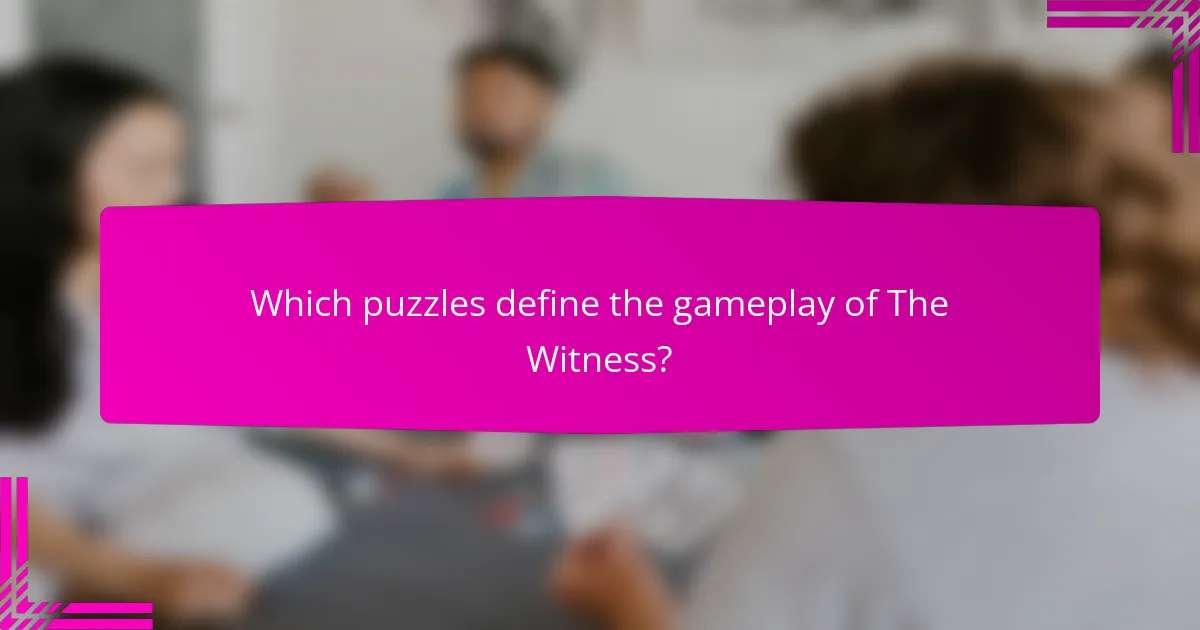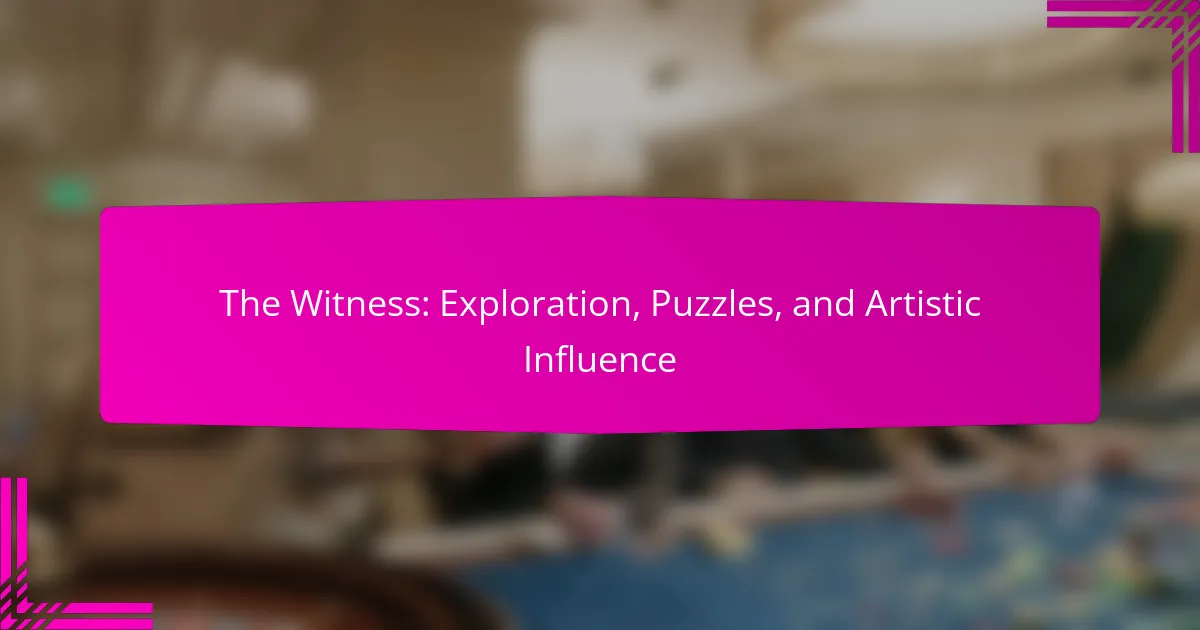The Witness provides players with a unique opportunity to enhance problem-solving skills while exploring a vibrant island filled with intricate puzzles. The game emphasizes environmental storytelling, allowing for non-linear exploration and personal agency. Its artistic influence challenges conventional gameplay, integrating visual design and sound to create an immersive experience. Players face various challenges that promote critical thinking and a deeper appreciation for art and design.

What makes The Witness a unique exploration experience?
The Witness offers a unique exploration experience through its open-world design, intricate puzzles, and stunning visual artistry. Players navigate a vibrant island filled with challenging enigmas that require observation and critical thinking. The game emphasizes environmental storytelling, allowing players to uncover the narrative through exploration rather than dialogue. Its minimalist aesthetic and immersive sound design enhance the overall experience, creating a serene yet thought-provoking atmosphere. Each puzzle is a carefully crafted component of the landscape, encouraging a deep connection between the player and the environment.
How does the game design enhance player immersion?
The game design in “The Witness” significantly enhances player immersion through its intricate environment and challenging puzzles. The open-world setting invites exploration, encouraging players to engage deeply with their surroundings. The artistic influence, characterized by vibrant visuals and minimalist aesthetics, creates a captivating atmosphere that draws players into the game world.
Puzzles are seamlessly integrated into the landscape, making problem-solving a natural part of exploration. This design choice fosters a sense of discovery, as players uncover solutions by observing their environment. The lack of traditional narrative elements allows players to interpret their journey, enhancing personal connection and immersion.
Overall, the combination of exploration, artistic influence, and puzzle integration creates a unique experience that captivates players and enhances their engagement with the game.
What environmental storytelling techniques are used?
The Witness employs various environmental storytelling techniques to immerse players in its world. These techniques include visual cues, environmental design, and subtle narrative elements that convey themes without explicit dialogue.
Players encounter intricate landscapes that reflect the game’s philosophical underpinnings. For instance, the architecture and natural features often symbolize concepts of isolation and discovery. Additionally, puzzles are integrated into the environment, encouraging exploration and engagement with the surroundings.
The use of color and light further enhances the storytelling, guiding players through emotional experiences. Each area of the game presents unique visual motifs that contribute to the overarching narrative, allowing players to interpret the story through their interactions.
Overall, environmental storytelling in The Witness is a multifaceted approach that deepens player engagement and enriches the gaming experience.

Which puzzles define the gameplay of The Witness?
The gameplay of The Witness is defined by a variety of intricate puzzles that challenge players’ perception and logic. These puzzles primarily involve line-drawing mechanics on panels, requiring players to observe environmental cues and apply critical thinking. The game emphasizes exploration, encouraging players to discover clues and solve puzzles in a non-linear fashion. Unique attributes include the integration of visual art and sound, enhancing the immersive experience. Rarely, puzzles may involve abstract concepts, prompting deeper philosophical reflections.
What are the different types of puzzles encountered?
The Witness features various puzzle types that challenge players’ perception and logic. These include line puzzles, environmental puzzles, and audio puzzles, each designed to enhance exploration and engagement. Line puzzles require players to connect dots on panels, while environmental puzzles involve manipulating the surroundings to reveal clues. Audio puzzles challenge players to listen and interpret sounds to progress. Each type contributes to the overall artistic influence and immersive experience of the game.
How do puzzles contribute to the narrative?
Puzzles in “The Witness” enhance the narrative by integrating gameplay with environmental storytelling. Each puzzle reflects the game’s themes of perception and understanding, allowing players to engage deeply with the world. The design encourages exploration, where solving puzzles reveals layers of meaning, contributing to the overall immersive experience. This connection between puzzles and narrative fosters a unique interaction, making players active participants in unfolding the story.

How does The Witness influence artistic expression in gaming?
The Witness significantly influences artistic expression in gaming through its immersive environments and intricate puzzles. The game prioritizes visual storytelling, encouraging players to engage with its artful landscapes. This design choice promotes a deeper emotional connection, elevating the overall gaming experience. The use of color, light, and geometry in The Witness serves as a unique attribute that enhances its artistic impact. By challenging conventional gameplay mechanics, it inspires other developers to explore artistic expression as a core element in their own projects.
What artistic styles are reflected in the game’s environment?
The game’s environment reflects various artistic styles, primarily influenced by minimalism and modernism. The use of vibrant colors and geometric shapes creates a visually striking landscape. Additionally, the integration of natural elements emphasizes a connection to the environment. Unique attributes include the incorporation of architectural influences from notable designers, enhancing the overall aesthetic experience. The interplay between puzzles and scenery further enriches the artistic narrative, inviting players to engage deeply with the world.
How does the game’s visual design impact player perception?
The game’s visual design significantly enhances player perception by creating an immersive and thought-provoking environment. The vibrant colors and intricate landscapes of “The Witness” engage players, making exploration feel rewarding. This artistic influence fosters a deeper emotional connection to the puzzles and the overall experience. Unique attributes like the minimalist style and attention to detail invite players to observe their surroundings, enhancing cognitive engagement and problem-solving skills. As a result, players perceive the game not just as a challenge but as a piece of art, enriching their journey through the island.

What role does player choice play in The Witness?
Player choice significantly influences gameplay in The Witness by shaping puzzle-solving experiences and exploration paths. Players determine their approach to solving intricate puzzles, which fosters a sense of personal agency. This freedom enhances engagement and encourages diverse strategies. Additionally, player choice impacts the interpretation of the game’s artistic themes, allowing for unique personal experiences. The interplay between choice and puzzle design creates a rich, immersive environment that resonates with each player differently.
How does exploration affect puzzle-solving strategies?
Exploration enhances puzzle-solving strategies in “The Witness” by promoting observation and critical thinking. Players engage with the environment, uncovering clues that inform their approach to puzzles. This interaction fosters a deeper understanding of spatial relationships and patterns, essential for effective problem-solving. The game’s artistic design also influences exploration, encouraging players to notice subtle details that aid in puzzle completion.
What are the consequences of player decisions in the game?
Player decisions in “The Witness” significantly impact puzzle progression and narrative engagement. Each choice influences the exploration of the island and the understanding of its themes. Players encounter multiple pathways, leading to unique experiences and insights. The consequences of decisions are reflected in the player’s ability to solve puzzles, revealing deeper layers of the game’s artistic influence.

What challenges do players face while navigating The Witness?
Players face various challenges in “The Witness,” including complex puzzles, environmental navigation, and thematic interpretation. The intricate puzzle designs require critical thinking and observation skills. Additionally, the open-world exploration can lead to disorientation, making it difficult to track progress. The game’s artistic influence adds layers of meaning, which may confuse players seeking straightforward solutions. These elements combine to create a uniquely engaging yet challenging experience.
How can players overcome common obstacles in puzzle-solving?
Players can overcome common obstacles in puzzle-solving by employing strategic approaches. Utilizing observation skills is essential; players should carefully examine their surroundings for clues. Breaking down complex puzzles into smaller parts simplifies the problem and makes it more manageable. Collaboration with other players can provide fresh perspectives and solutions. Additionally, players should not hesitate to experiment with different approaches, as trial and error often leads to breakthroughs. Maintaining patience is crucial; frustration can cloud judgment and hinder progress. Lastly, players can benefit from taking breaks to clear their minds, allowing them to return with renewed focus.
What strategies can enhance the exploration experience?
Engaging with “The Witness” can be enhanced through several strategies. Firstly, immerse yourself in the environment; observing details can reveal hidden puzzles. Secondly, take notes on patterns and symbols encountered; this aids in solving interconnected challenges. Thirdly, approach puzzles with a fresh mindset; stepping away can lead to new insights. Lastly, collaborate with others; discussing ideas can uncover different perspectives and solutions.
What are the most frequently encountered player frustrations?
Players frequently encounter frustrations in “The Witness” due to the game’s challenging puzzles and ambiguous visual cues. These elements can lead to confusion and feelings of frustration when solutions are not immediately clear. Additionally, the open-world design may cause players to feel lost or overwhelmed, as they navigate various environments without explicit guidance. The lack of narrative context can also contribute to player dissatisfaction, as some may seek a more cohesive story to accompany the gameplay.

How does The Witness compare to other puzzle games?
The Witness stands out among puzzle games for its immersive exploration, intricate puzzles, and striking artistic influence. Unlike many games, it offers a seamless connection between environment and challenge, encouraging players to think critically about their surroundings.
In comparison to other puzzle games, The Witness emphasizes environmental storytelling. Players engage with a vibrant island, where each puzzle integrates into the landscape, enhancing the overall experience. This contrasts with more traditional puzzle games that often rely on static screens or isolated challenges.
Additionally, The Witness features a unique attribute: its non-linear progression. Players can approach puzzles in any order, fostering a sense of freedom and personal exploration that is rare in the genre. This design choice promotes deeper engagement and allows for varied player experiences.
Overall, The Witness combines exploration, puzzle-solving, and artistic expression in a way that elevates it above many other titles in the puzzle genre.
What are the key differences in gameplay mechanics?
The key differences in gameplay mechanics of “The Witness” include exploration, puzzle-solving, and artistic influence. Exploration involves navigating a vast, open world filled with intricate environments. Puzzle-solving focuses on line puzzles that require observation and critical thinking. Artistic influence shapes the game’s aesthetic, enhancing immersion and engagement. Each mechanic contributes uniquely to the overall experience, making it distinct and memorable.
How does player feedback shape the game’s community?
Player feedback significantly influences the community of “The Witness” by shaping game updates and fostering engagement. Developers actively incorporate player insights to enhance puzzle design and exploration elements, creating a more immersive experience. This feedback loop strengthens community bonds as players share strategies and discoveries, reinforcing the game’s artistic influence. As a result, player involvement directly impacts the game’s evolution and the collective enjoyment of its intricate world.

What are the long-term impacts of playing The Witness?
Playing The Witness can lead to enhanced problem-solving skills and a deeper appreciation for art and design. The game’s intricate puzzles encourage critical thinking and patience. Players often experience improved spatial awareness and cognitive flexibility. Additionally, the serene environment fosters mindfulness, offering long-term mental health benefits. Engaging with its artistic elements can inspire creativity in other areas of life.
How does the game influence critical thinking skills?
The game enhances critical thinking skills through its complex puzzles and open-world exploration. Players must analyze their surroundings, identify patterns, and devise strategies to progress. This process fosters problem-solving abilities and encourages players to think critically about their choices. Engaging with the artistic elements of the game further stimulates creative thinking, as players interpret visual cues and narrative themes. Each puzzle solved reflects a deeper understanding of logical reasoning and cognitive flexibility, essential components of critical thinking.
What lasting impressions do players take away from the experience?
Players take away a profound sense of accomplishment and appreciation for artistry. The Witness combines intricate puzzles with a stunning open-world environment, creating lasting memories. Many players reflect on the game’s philosophical themes, which challenge their perceptions and encourage deeper thinking. The unique visual style and immersive sound design enhance emotional connections, making the experience memorable.
What are the best practices for new players approaching The Witness?
To succeed in The Witness, new players should focus on exploration, patience, and observation. Engaging with the environment reveals clues essential for solving puzzles.
1. Explore thoroughly: Discover new areas and interact with various elements to uncover hidden patterns.
2. Observe surroundings: Pay attention to visual cues and environmental details that guide puzzle solutions.
3. Take notes: Document patterns and insights to aid memory and understanding of complex puzzles.
4. Practice patience: Some puzzles may take time to solve; avoid frustration by stepping away if needed.
These strategies enhance the overall experience and deepen appreciation for the game’s artistic influence.
